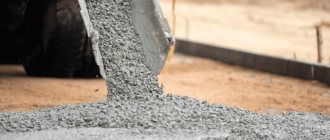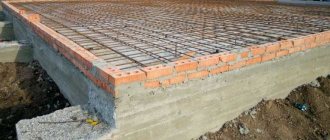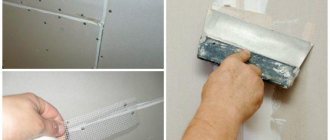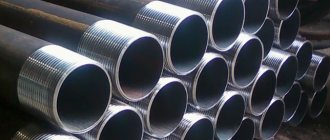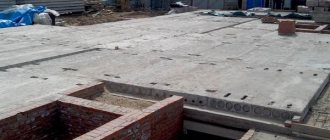Maintenance of country houses requires a large amount of water. The liquid is consumed by showers, dishwashers and washing machines. Previously used water sources do not satisfy the needs of owners of modern cottages. In this case, it may be necessary to drill a well in the well.
A large amount of silt and water with impurities are the most common reasons for upgrading a well by drilling wells to aquifers.
Reasons for modernization
A decrease in well productivity is caused by the following reasons:
- Sludge formation. If the source has not been used for a long time, a coating forms on the bottom and walls, deteriorating the quality of the extracted resource.
- Damage to casing elements. Occurs when the ground freezes or moves. Soil particles penetrate through the resulting defects and pollute the water.
- The appearance of harmful impurities in the produced liquid. Well water rises from a depth of 5-10 m. It comes from streams originating on the surface of the earth. Precipitation is filtered by a sand layer and penetrates into the aquifer of the soil. At these stages, the water is saturated with harmful impurities contained in the air and soil. Nitrates and heavy metal salts make the liquid unsuitable for consumption.
It is recommended to extract water by drilling a mine to deep aquifers. A budget option is to install a well in an existing well.
Drilling a well next to a well is a more affordable solution than upgrading an existing well.
Drilling technology
At the preparatory stage, it is necessary to check the concrete rings or other material of the walls of the vault for defects. Such actions will eliminate the possibility of destruction of the structure. When using an ancient wooden well, the structure will need to be strengthened.
Drilling technology has some difficulties:
- The work is carried out during the period of absence of significant precipitation. The right time of year to drill a well is the second half of summer (late July and August).
- The formation of a mine in winter is possible when the water freezes. Cold air arrives within 4-6 days.
- After installation is completed, specialists partially fill the shaft with earth, eliminating the possibility of further exploitation of the well. Classic technologies are used - rotary, impact-contact, screw.
The listed methods do not require cleaning and disposal of earthen rocks. The entry of soil into aquifers does not pose a danger, since the well will no longer be in use. To avoid accidents, the casing pipe and drill are installed on wooden plywood. The flooring covers the perimeter of the pit to prevent anyone from falling.
Drilling is carried out by installing equipment on the walls. Then I attach a large pipe in which I use a coarse filter. The conductor must be retracted to the surface to avoid displacement; the length is adjusted by couplings. A surface pump is installed to ensure the flow of water from the well. It can be connected to the pipeline using the thread method. The finished structure is connected to the water supply system.
Geological preparation is rarely carried out when a well is installed on the basis of an old well. The depth of the aquifer is unknown in advance. The material is calculated with a margin so that the casing pipe is enough. The key rule is to stop the structure from sinking at the moment the aquifer is opened. When the pipe sinks deep into hard rock, water supply becomes impossible.
Well inside a well
This method of water extraction does not always help save money. It is more profitable to drill a well nearby. The power of professional equipment allows you to complete the work in a short time.
Therefore, most specialized companies prefer to develop water sources on flat areas. The depth of the mine is measured from ground level. This option is also beneficial for the customer. A well installed in a new location is easy to maintain and operate.
Private teams using low-power drilling rigs undertake the deepening of existing wells on the site. In this case, it is necessary to strengthen the walls of the shaft, build rigid frames, and secure casing rings and pipes. By using an existing mine, drilling costs can be reduced.
Independent work
The well has dried up completely, and by deepening the structure you can create a bunch of insoluble problems. There is another technique that is quite widespread:
- A hand drill is used to drill a hole inside a dry well. Owners of problematic wells in houses and cottages believe that in this way they can restore water supply and achieve the return of water.
- Taking into account that the depth of wells is often from 5 to 8 meters, and the well water horizon lies at 15-16 meters, it is not difficult to perform simple arithmetic calculations. It is almost impossible to carry out such independent work manually, in a deep well, in a cramped position where there is not enough air. In addition, breaking through the aquiclude between the layers, which can be represented by dense clay, in which there are inclusions of gravel and pebbles, is simply an impossible task.
Attention: This method is used to determine the possibilities of deepening a well with rings of smaller diameter; for this purpose, 2-3 meters are drilled with a hand drill.
- You can acquire your own equipment for drilling using the auger method. To do this, you need to purchase a compact tower, drive, rods, fastenings, and a working tool - auger. The most important thing is to prepare the drill. Craftsmen perform it in several ways. The most common are augers from used combine harvesters that have been retrofitted into a drilling rig.
- The upper end of the drill is decorated with a threaded coupling, used for screwing on extension rods.
- The lower tubular part is transformed into a screw, or rather into its semblance. From the helical end, retreating 0.8 m, 2 knives are welded at an angle of 25ᵒ to the horizontal. This is one way.
- Another option is based on the design of an ordinary fishing ice ax. The only change is that the crown edges are reinforced with welded cutters and that’s it, you can drill.
Before starting work, it is necessary to stock up on casing pipes so that the well does not quickly become covered with soil and become unusable. It is necessary to think about how to connect them. This could be soldering or threading. Since it is not possible to determine the exact level of water, approximate calculations will have to be made. So many problems and questions arise in these matters that it is worth thinking about whether the price of the issue is worth such efforts to do independent work or still trust the specialists.
In what cases is it necessary to make a deepening?
To understand whether it is worth deepening a well, you need to study the structure of the soil layers.
Cloudiness of water and harmful impurities are usually associated with insufficient depth of the well or well.
They are arranged in this order:
- Fertile layer. Located on the surface, covered with vegetation.
- Clay and loamy layers. These rocks do not pass water well. Such formations may contain sand inclusions from underground streams.
- Sandstone layer. The layer covered with a clay crust contains a large amount of water. Sand moves with the liquid, forming quicksand.
- Clay with granite and boulders.
- Aquiferous sand layer. The layer lies on the surface of porous limestones, in the thickness of which lies artesian water.
Simple wells receive only surface or groundwater. The watershed may be limited by quicksand that are impossible to see. With frequent mining of a resource, a pocket is formed in the sand, containing a certain amount of liquid. This volume is sufficient to meet minimum needs.
But this amount is not enough to service a private home. A slight increase in the depth of the well does not eliminate the problem, so the owner decides to drill a well. The process does not cause difficulties if the drill does not rest against the granite layer.
When repairing a concrete well shaft, special attention is paid to sealing the gaps between the rings.
Financial side of the issue
When carrying out excavation work, the cost directly depends on how deep the shaft will be. The shallower its depth, the cheaper the device will cost the site owner. From this point on, the cost of a well will be less than that of a well.
The cost of installing the latter is influenced by the topography of the site, the type of soil, the depth at which the aquifer lies, etc.
If the water is at a depth of up to 16 m, and the terrain does not create difficulties, then the cost of the device will be comparable to the cost of a well, and maintaining the well will be even cheaper. You need to consider the costs not only of drilling a well or shaft and installing a pump, but also of water filtration and disinfection.
Comparative cost of water intake
For many owners, the question of choosing which is better, a well or a well, is far from idle. After all, it is he who determines the cost of construction and maintenance of water production facilities.
When calculating the estimated cost of water intake, a number of parameters should be taken into account:
- excavation work based on each linear meter in depth;
- volume of materials to strengthen the walls of the penetration;
- frequency of maintenance of the structure.
Due to the low cost of excavation work, which can be performed without the use of heavy special equipment, many summer residents, gardeners and villagers can afford to install a well.
The estimated cost of completing a well varies from 30 to 40 thousand rubles.
It includes:
- Installation of a bottom filter (4-5 thousand rubles).
- Filtration gravel filling (1-1.5 thousand rubles).
- External house for the head (from 7 thousand rubles).
- Submersible pump with installation (15 + 7 = 22 thousand rubles).
Construction of a well without taking into account the laying of communications from the point of water intake to the points of consumption will cost about 100 thousand rubles. The cost depends on the time of year, drilling depth and equipment used. We examined in more detail the main factors influencing the final cost of constructing a well in this article.
The well package includes many components, including a pump, caisson, control devices and a hydraulic accumulator, the cost of which amounts to tens of thousands of rubles
The price of a pump for a mine well is also much cheaper in comparison with the pumping equipment required when constructing a well.
In which well can a well be made?
There are no regulatory documents regulating the construction of wells in wells. Before starting drilling, make sure that the work will not cause the collapse of the casing structure and will not affect the properties of water.
The existing structure is inspected for visible and possible defects. Cracks and chips are eliminated, the casing elements are given the correct position. Log structures are strengthened and tied.
Durable concrete products also require inspection. The casing must have no gaps or moving parts. The mine is given a strictly vertical location.
The displacement of the rings indicates the mobility of the soil layers. In this case, the drilled well will cause rapid flows of water to enter, destroying the casing.
Typically, when drilling wells in wells, auger drills are used, but if necessary, other options with a larger diameter can be selected.
Choosing a location for a water source
The well must be located at a distance of at least 30 meters from sources of dirt (manure heaps, toilets, cesspools, bathhouses). If a well is installed, the distance can be reduced to 15 meters. It is not recommended to build a well on the slope of a ravine or on the bank of a river, since in this case the main source will be dirty groundwater.
Whatever water extraction system is chosen, it is necessary to ensure the passage and placement of the contractor's equipment and machines, as well as the availability of space for materials on the site. In the case of wells, additional territory is required for disposal of the excavated soil. If a house has not yet been built on the site, you can cut a well directly in the building area. This will significantly reduce the cost of pipelines and caissons, but can become a problem when carrying out well repairs.
Strengthening and reinforcing structures
Strengthen the following structural elements with your own hands:
- Casing string. Strengthening a concrete structure is easier. To do this, anchor bolts are driven into the walls of the lower, middle and upper rings. Vertical beams made of profiles are attached to them. Edging rods are welded to the parts, forming a square. Reinforcing bars are placed in the corners of the resulting figure.
- Conductor. To begin, select the point at which drilling will begin. A pipe is driven into the bottom of the well, around which corners are placed. Metal elements are welded together. If the casing string was previously tied, the structures are combined. Drilling equipment with a gate block is installed above the well. Concrete slabs are placed under the legs of the apparatus.
Time to make a well
It is recommended to carry out the work in August-September. During this period, aquifers contain the least amount of resource. When performing work in winter, the water is frozen. To do this, a borehole pump is inserted into the well, which is attached to a conductor pipe and supplies cold air currents. The liquid freezes in 3-7 days.
The drilling technology is no different from that in the summer. The height of the conductor must reach ground level. The pipe must be buried below the sandstone layer. If necessary, the height of the conductor is increased by screwing on the couplings. After completion of the work, the free space is filled up, which protects the well from wastewater.
External water supply
When installing a water supply system for a private house from a well with a hydraulic accumulator, it is important to correctly lay the pipes outside. Products made from HDPE are considered the best options. Low-density polyethylene withstands temperature changes well, is easy to install, and is resistant to deformation
Low-density polyethylene withstands temperature changes well, is easy to install, and is resistant to deformation.
For laying pipes, you need to dig a trench from the caisson to the foundation of a cottage, swimming pool, etc. The depth of the channel is below the freezing level of the soil. This parameter is often 0.8-1.5 m depending on the region.
The pipes are joined using special electric couplings. When heated, they melt the HDPE material and make the joints airtight.
It is better to enter the line into the house through the foundation. Here you should use a hammer drill bit to make a hole. It is reinforced with a steel sleeve. The water supply to the house from the well is hermetically sealed, and all gaps are additionally coated with bitumen mastic.
